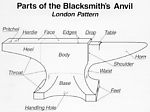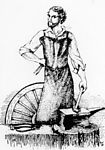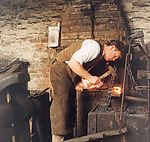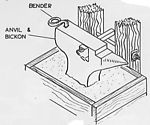Chain has been made by humankind for thousands of years. Chainmaking was done by the Blacksmith, and his chains would have been used for harnessing animals.
Ships used hemp rope to secure them to the dockside or to support the anchor. The problem with hemp is that it rots and can be cut by sharp objects.
By the way, chains on ships are referred to as “cables”.
In the early part of the nineteenth century the Navy was trying the “new” iron cable-chain. Hemp had to be imported and this made it expensive, so the Navy wanted an alternative.
The best metal for making chains is wrought iron, as it withstands sudden shock loads without cracking or breaking, unlike cast-iron, which is brittle. Around the late eighteenth century foundries were casting larger and heavier objects. Hemp rope was no longer up to the job.
Gilbert Gilpin tried using chain for winding up the shafts at local collieries, and in 1805 he won a silver medal and 30 guineas for the work he had done on perfecting iron chains. In 1807 he set up his own works in Coalport making chains for use in pits and on cranes.
The making of the first cable-chain in this country is credited to Robert Flinn at his workshop in South Shields in 1808. Cable-chains were in use in France prior to this date.
The first iron cable-chain made in this country was for the 221 ton ship,"Ann and Isabella". Its worth was proven when several other ships using hemp cables were tied to her during a severe storm. The iron cable held fast, but the hemp cables were cut through by pieces of floating ice.
The Navy was impressed with reports received about the effectiveness of iron cable-chain. Over the next few decades confidence grew in the use of iron cables, and so their use was extended until they replaced hemp.
The merchant fleets were slower in adopting iron cable, as the insurance companies imposed a premium on policies for ships using them. But once it became apparent that iron cables out-performed hemp, the premium was removed.
From this time on the chain industry grew into an industry for which the region was famous.
Rollover the captions in the box to see the available images in thumbnail format, click the caption to see the full-size image
| Reference: | 656 |
| Keywords: | |
| Archive Ref: | |
| Updated: | Thu 17 Apr 2008 - 1 |
| Interpretation written by | Louis Howe |
| Author's organisation | Curatorial |
| Organisation's website |



